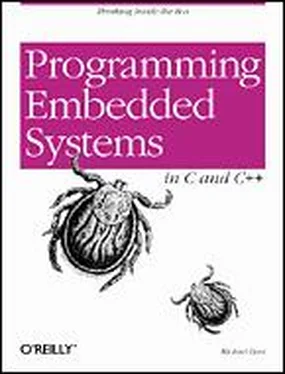Unfortunately, embedded operating systems cannot use any of these simplistic scheduling algorithms. Embedded systems (particularly real-time systems) almost always require a way to share the processor that allows the most important tasks to grab control of the processor as soon as they need it. Therefore, most embedded operating systems utilize a priority-based scheduling algorithm that supports preemption. This is a fancy way of saying that at any given moment the task that is currently using the processor is guaranteed to be the highest-priority task that is ready to do so. Lower-priority tasks must wait until higher-priority tasks are finished using the processor before resuming their work. The word preemptive adds that any running task can be interrupted by the operating system if a task of higher priority becomes ready. The scheduler detects such conditions at a finite set of time instants called scheduling points.
When a priority-based scheduling algorithm is used, it is also necessary to have a backup policy. This is the scheduling algorithm to be used in the event that several ready tasks have the same priority. The most common backup scheduling algorithm is round robin. However, for simplicity's sake, I've implemented only a FIFO scheduler for my backup policy. for that reason, users of ADEOS should take care to assign a unique priority to each task whenever possible. This shouldn't be a problem though, because ADEOS supports as many priority levels as tasks (up to 255 of each).
The scheduler in ADEOS is implemented in a class called Sched :
class Sched {
public:
Sched();
void start();
void schedule();
void enterIsr();
void exitIsr();
static Task * pRunningTask;
static TaskList readyList;
enum SchedState { Uninitialized, Initialized, Started };
private:
static SchedState state;
static Task idleTask;
static int interruptLevel;
static int bSchedule;
};
After defining this class, an object of this type is instantiated within one of the operating system modules. That way, users of ADEOS need only link the file sched.obj to include an instance of the scheduler. This instance is called os and is declared as follows:
extern Sched os;
References to this global variable can be made from within any part of the application program. But you'll soon see that only one such reference will be necessary per application.
8.2.2.1 Scheduling points
Simply stated, the scheduling points are the set of operating system events that result in an invocation of the scheduler. We have already encountered two such events: task creation and task deletion. During each of these events, the method os.schedule is called to select the next task to be run. If the currently executing task still has the highest priority of all the ready tasks, it will be allowed to continue using the processor. Otherwise, the highest priority ready task will be executed next. Of course, in the case of task deletion a new task is always selected: the currently running task is no longer ready, by virtue of the fact that it no longer exists!
A third scheduling point is called the clock tick. The clock tick is a periodic event that is triggered by a timer interrupt. The clock tick provides an opportunity to awake tasks that are waiting for a software timer to expire. This is almost exactly the same as the timer tick we saw in the previous chapter. In fact, support for software timers is a common feature of embedded operating systems. During the clock tick, the operating system decrements and checks each of the active software timers. When a timer expires, all of the tasks that are waiting for it to complete are changed from the waiting state to the ready state. Then the scheduler is invoked to see if one of these newly awakened tasks has a higher priority than the task that was running prior to the timer interrupt.
The clock tick routine in ADEOS is almost exactly the same as the one in Chapter 7. In fact, we still use the same Timer class. Only the implementation of this class has been changed, and that only slightly. These changes are meant to account for the fact that multiple tasks might be waiting for the same software timer. In addition, all of the calls to disable and enable have been replaced by enterCS and exitCS, and the length of a clock tick has been increased from 1 ms to 10 ms.
The scheduler uses a data structure called the ready list to track the tasks that are in the ready state. In ADEOS, the ready list is implemented as an ordinary linked list, ordered by priority. So the head of this list is always the highest priority task that is ready to run. Following a call to the scheduler, this will be the same as the currently running task. In fact, the only time that won't be the case is during a reschedule. Figure 8-2 shows what the ready list might look like while the operating system is in use.
Figure 8-2. The ready list in action
The main advantage of an ordered linked list like this one is the ease with which the scheduler can select the next task to be run. (It's always at the top.) Unfortunately, there is a tradeoff between lookup time and insertion time. The lookup time is minimized because the data member readyList always points directly to the highest priority ready task. However, each time a new task changes to the ready state, the code within the insert method must walk down the ready list until it finds a task that has a lower priority than the one being inserted. The newly ready task is inserted in front of that task. As a result, the insertion time is proportional to the average number of tasks in the ready list.
If there are no tasks in the ready state when the scheduler is called, the idle task will be executed. The idle task looks the same in every operating system. It is simply an infinite loop that does nothing. In ADEOS, the idle task is completely hidden from the application developer. It does, however, have a valid task ID and priority (both of which are zero, by the way). The idle task is always considered to be in the ready state (when it is not running), and because of its low priority, it will always be found at the end of the ready list. That way, the scheduler will find it automatically when there are no other tasks in the ready state. Those other tasks are sometimes referred to as user tasks to distinguish them from the idle task.
Because I use an ordered linked list to maintain the ready list, the scheduler is easy to implement. It simply checks to see if the running task and the highest-priority ready task are one and the same. If they are, the scheduler's job is done. Otherwise, it will initiate a context switch from the former task to the latter. Here's what this looks like when it's implemented in C++:
/**********************************************************************
*
* Method: schedule()
*
* Description: Select a new task to be run.
*
* Notes: If this routine is called from within an ISR, the
* schedule will be postponed until the nesting level
* returns to zero.
*
* The caller is responsible for disabling interrupts.
*
* Returns: None defined.
Читать дальше












